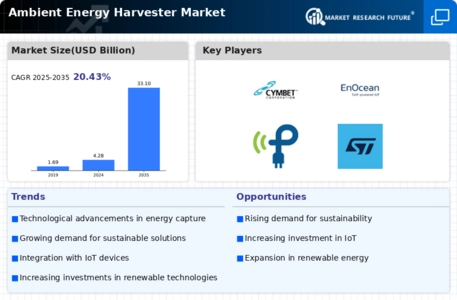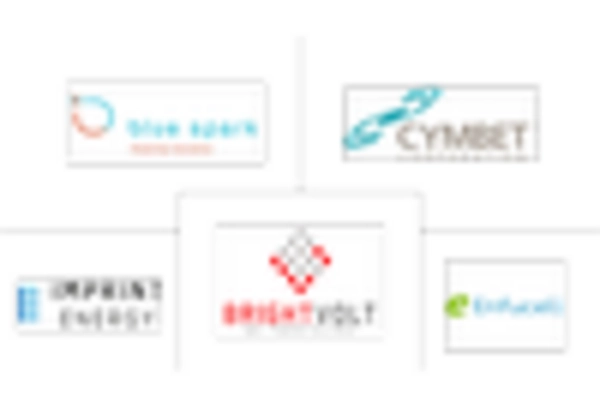Rising Demand for Renewable Energy
The increasing The Ambient Energy Harvester Industry. As nations strive to meet sustainability goals, the demand for technologies that harness ambient energy, such as solar, thermal, and kinetic energy, is surging. According to recent data, the renewable energy sector is projected to grow at a compound annual growth rate of over 8% in the coming years. This growth is likely to stimulate investments in ambient energy harvesting technologies, as they offer a viable solution for reducing reliance on fossil fuels. Furthermore, the integration of these technologies into various applications, including consumer electronics and smart devices, enhances their market appeal. The Ambient Energy Harvester Market is thus positioned to benefit from this trend, as more industries seek to adopt cleaner energy solutions.
Integration with Smart Technologies
The integration of ambient energy harvesting technologies with smart devices is emerging as a key driver for the Ambient Energy Harvester Market. As the Internet of Things (IoT) continues to proliferate, the need for energy-efficient solutions becomes paramount. Ambient energy harvesters provide a sustainable power source for IoT devices, which often require continuous energy supply for optimal functionality. The market for IoT devices is expected to grow significantly, with estimates suggesting a compound annual growth rate of over 25% in the next few years. This growth presents a substantial opportunity for the Ambient Energy Harvester Market, as manufacturers seek to develop energy harvesting solutions that can power a multitude of connected devices without relying on traditional batteries.
Government Initiatives and Incentives
Government policies and incentives aimed at promoting renewable energy adoption are significantly influencing the Ambient Energy Harvester Market. Many countries have implemented tax credits, grants, and subsidies to encourage the development and deployment of energy harvesting technologies. For example, initiatives that support research and development in clean energy technologies have led to increased funding for projects focused on ambient energy harvesting. This support is crucial, as it not only fosters innovation but also lowers the financial barriers for companies looking to enter the market. As a result, the Ambient Energy Harvester Market is likely to experience accelerated growth, driven by favorable regulatory environments and financial incentives that promote the use of sustainable energy solutions.
Growing Consumer Awareness of Sustainability
Consumer awareness regarding environmental issues is a significant driver for the Ambient Energy Harvester Market. As individuals become more conscious of their carbon footprints, there is a rising demand for products that utilize renewable energy sources. This shift in consumer behavior is prompting manufacturers to incorporate energy harvesting technologies into their products, ranging from smart home devices to electric vehicles. Market Research Future indicates that products featuring sustainable energy solutions are increasingly preferred by consumers, leading to a projected increase in sales for companies that adopt these technologies. Consequently, the Ambient Energy Harvester Market is likely to expand as businesses respond to this demand by integrating energy harvesting capabilities into their offerings.
Advancements in Energy Harvesting Technologies
Technological innovations play a crucial role in shaping the Ambient Energy Harvester Market. Recent advancements in materials science, such as the development of more efficient piezoelectric materials and improved photovoltaic cells, have significantly enhanced the performance of energy harvesting devices. For instance, the efficiency of solar energy converters has improved, allowing for better energy capture even in low-light conditions. This progress is reflected in the market, where the energy harvesting technology segment is expected to witness a growth rate of approximately 10% annually. Additionally, the miniaturization of energy harvesting devices has made them more suitable for integration into a wide range of applications, from wearable technology to remote sensors. As these technologies continue to evolve, they are likely to drive further adoption within the Ambient Energy Harvester Market.


















Leave a Comment